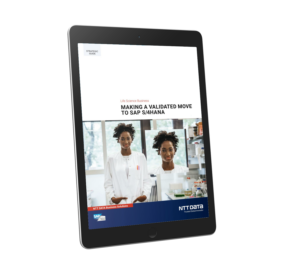Life Sciences – How a Brownfield Conversion to SAP S/4HANA Works

(5 minute read)
If you’ve worked with SAP ECC in life sciences for a long time and built many business processes around it, you might be reluctant to start all over again with a greenfield implementation. Luckily, a completely new implementation isn’t the only way to shift your organization to SAP S/4HANA. With the brownfield approach, it’s possible to migrate without changing any of your business processes. With a partner like NTT DATA Business Solutions, you can also transition on a fixed schedule and budget in a validated way. In this post, we’ll explain how.
What Is a Brownfield System Conversion?
First, let’s define what a brownfield system conversion is. A system conversion means migrating data and functionality from an existing system (in this case SAP) to a new platform (SAP S/4HANA). This is different from a greenfield implementation, where you start from scratch by re-implementing functionality and migrating data.
Many businesses opt for a brownfield conversion because they’ve developed many valuable and unique business processes around the old system, have valuable historic data, and want to avoid re-training staff or redesigning processes that worked well. With a brownfield conversion, the process of verification (checking that all systems and processes work) is also significantly easier.
Like renovating a house, the brownfield approach allows you to keep all the features you liked in your old system. Only now, the foundations have been upgraded and new features are available to discover at your own pace.
More Benefits of Brownfield
-
No Extensive Revalidation
A majority of SAP ECC functions have been carried across to SAP S/4HANA, so there’s no need for extensive revalidation in a brownfield conversion. Simple verification tests are all that’s required.
-
No Retraining Required
With existing functionality untouched, your staff can continue using the functionality they’ve become accustomed to and perfected over the years. Instead of setting up new processes and running extensive retraining sessions, you can allow your staff to use the new system as they did before. Core users will require only minimal instruction, which saves you time and money.
-
Choose your User Experience
Of course, the new Fiori user interface will bring new functionalities and boost your efficiency, but you can still choose to adopt step-by-step or team-by-team.
-
Save Time and Budget
A brownfield conversion will require minimal effort on the customer side and can be seen as a technical exercise. As processes remain largely the same, the impact on the business is minimal. A greenfield approach will require a lot more resources on the customer side and is budget-wise often not comparable.
-
Choose Which Elements to Use, When
SAP S/4HANA has surpassed SAP ECC in supported business processes and useability, but with a brownfield conversion, it still is possible to keep using most of the SAP ECC functionalities. Optimizing processes can be done at your own pace with the support of NTT DATA Business Solutions.
The Case for Converting Now
If your organization is running smoothly on SAP ECC or a similar SAP product, it can be difficult to justify investing to transition to SAP S/4HANA. However, waiting for the best moment often makes a conversion more difficult in the future. Conversion costs can be expensive when software nears the end of its support life, as skilled engineers become harder to find. With support for SAP ECC ending in 2027, talented engineers are currently in high demand.
As well as reducing costs in the long run, converting sooner means you’ll have more time to exploit the new features available in SAP S/4HANA. Immediate productivity increases could allow you to gain an advantage over competitors that was impossible prior.
The Conversion Factory
To make brownfield conversions as efficient and smooth as possible, NTT DATA Business Solutions has developed and established what we call The Conversion Factory. This team includes dedicated SAP-certified consultants, as well as validation experts with significant experience in life sciences. With direct access to these specialists, we’re able to move our clients to SAP S/4HANA sooner, with efficient fixed schedules, controlled budgets, and low risk.
Migration to SAP S/4HANA
No matter which stage of the journey to SAP S/4HANA you’re on, NTT DATA Business Solutions can help.
Perhaps you’ve evaluated all the technical features of SAP S/4HANA and are ready for a concrete migration plan. We can define the features that need to be implemented, a roadmap, the team setup, and the workload of the units concerned. For companies at an earlier stage, we can provide a high-level roadmap and help you to build a business case for management.
Next Steps
Businesses running legacy SAP software are typically in one of three scenarios.
Scenario 1 – No Transition Plan: Those who’d like to hold on to their current platform for as long as possible, even if they’re aware of the 2027 deadline.
Scenario 2 – Planning: Those who understand the business case for SAP S/4HANA but are unsure how to quantify the benefits for their organization.
Scenario 3 – Ready To Execute: Companies who are ready to migrate to SAP S/4HANA as soon as possible.
No matter which scenario your organization is in, our consultants can help. Businesses planning to retain their current platform for as long as possible can plan their future with greater confidence. Those at the planning stage can receive detailed plans with expected outcomes to present to decision-makers. While those at the execution stage benefit from comprehensive transition plans with time and budget guarantees.
To start creating the future you want for your organization, start a conversation with one of our experts.
Alternatively, download our white paper to learn more:

Our white paper ‘Making a Validated Move to SAP S/4HANA’ is a more detailed transition guide, written exclusively for life sciences professionals.